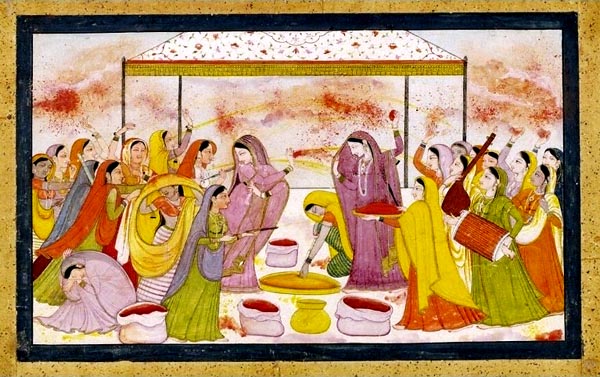 |
| Hindu goddess Radha celebrating Holi (Wikipedia) |
Note: Where did we get the tradition of "pranking" people on April Fools? This may once have been the date of New Years, a "liminal time" when the usual rules of polite society are suspended.
Get Ready: Have you ever "pranked" anyone--that is, played a trick on them?
April Fools!
You probably know all about this silly holiday: How people play jokes on their friends to make them look "foolish," then yell "April Fools!" and everyone has a good laugh, because it's all in fun.
You may also have heard some story about how it began. Perhaps you have heard that it was related to the change in the date of New Year, and how some people didn't accept the change, so they were mocked by others.
You may also have heard that some people doubt this story.
In other words, the origins of this tradition are not absolutely clear.
But I have spent much of my life studying the folklore of various cultures, and, in my opinion, the customs of "April Fools" are indeed related to the fact that this date used to be New Years.
You see, the Spring Equinox falls a week or so before April 1st, and the Equinox is an unusual time. This is when the night and day are exactly the same length; in modern times, it would be when sunrise and sunset are exactly 12 hours apart.
This indicates a peculiar kind of balance, an equilibrium in the affairs of heaven and, therefore, of humans.
So the ancients saw this as what we call a liminal time. Limin is the Latin word for "threshold," the bottom of a doorway. When we visit a temple, we have to step over a high board in the gateway, the demarcation between the sacred world inside and the profane one outside. Thresholds also divide the inside of a house from the outside, or one room from another.
The New Year, too, is a liminal time. It marks the boundary between an old year and a new. Why do families gather at this time? "It's tradition," you might say. But that tradition may have begun as a means of gathering together and ensuring protection for each other during a "dangerous" time.
In the old days in Europe, liminal times such as New Years were times when the rules would be changed, like the "topsy turvy day" in Disney's Hunchback of Notre Dame. This holds true for some festivals around the world today. Indian communities celebrate Holi, for example, when people throw colored powder and water on each other--something they would never dare do on other days!
So at liminal times, we are allowed to behave strangely. And I think that's how April Fools' Day got started. Whether because of the Equinox (as with Holi and other festivals) or the New Year, April 1st was a "liminal day," and it was (and is) ok to mock people in a way that would usually be unacceptable.
Just remember: You want them to still be your friends on April 2nd!
--------Read more: https://en.wikipedia.org/wiki/April_Fools%27_Day
Practice: Match the term to its definition below:
- affairs
- boundary
- demarcation
- ensuring
- equilibrium
- mock
- profane
- sacred
- topsy-turvy
- unacceptable
- balance of forces
- matters; interests
- line between two areas
- holy; special
- separation; marking off
- not okay
- common; everyday; not "special"
- making sure of
- upside-down
- make fun of
Answers are in the first comment below.
Submitted to the Shenzhen Daily for April 1, 2008--on April Fools' Day!


Answers to the Practice: 1. b; 2. c; 3. e; 4. h; 5. a; 6. j; 7. g; 8. d; 9. i; 10. f
ReplyDelete